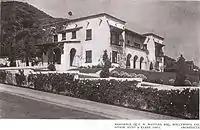Wattles Mansion
The Wattles Estate, originally known as Jualita, is a historic house and park in the Hollywood area of Los Angeles, California, United States. It was built in 1907 by wealthy Omaha, Nebraska, banker Gurdon Wattles as a winter home. Next to the Wattles Mansion are Wattles Park and Wattles Gardens, now administered by the City of Los Angeles and open to the public.
| Wattles Mansion | |
|---|---|
 The Wattles Mansion from the south | |

| |
| General information | |
| Architectural style | Mission Revival Style |
| Address | 1824 N Curson Avenue |
| Town or city | Los Angeles |
| Country | United States |
| Coordinates | 34°6′15.5″N 118°21′16.8″W |
| Completed | 1907 |
| Client | Gurdon Wattles |
| Owner | Los Angeles Department of Recreation and Parks |
| Design and construction | |
| Architect | Elmer Grey, Myron Hunt |
| Designated | May 25, 1993 |
| Reference no. | 579 |

The estate has been recognized as "the only remaining intact example of the once plentiful Hollywood estates from the period preceding the film industry, when Hollywood was primarily agricultural and was a wintering home for wealthy Easterners and Midwesterners."[1] According to the City of Los Angeles, "'Jualita' is one of the few remaining landscapes reminiscent of another era and tradition, possessing a genuine integrity of setting, design, workmanship, and association."[2]
History
Noted local architects Myron Hunt and Elmer Grey designed the Mission Revival residence in 1907 with grounds featuring a Japanese garden, an Italian rose garden, a formal Spanish garden, a palm court, and orchards.[3] It was one of Hollywood's first tourist attractions.[4] Wattles was responsible for gradually transforming 49 acres (200,000 m2) of agricultural land into orchards, thematic gardens and naturalistic landscapes based on his trips to Japan and Mexico.[3]
Prior to permanent residence in Los Angeles, Wattles headed the streetcar company in Omaha. His strike-breaking efforts contributed to four days of violence in the city in 1909. The attempt to unionize failed and many of the strikers had to seek work elsewhere, but the incident damaged Wattles' social standing and worsened relations between the city's rich and the general citizenry. A jury's refusal in 1906 to convict career criminal Pat Crowe for the kidnapping of Omaha packing house scion Edward Cudahy was widely seen as an expression of contempt for the city's ruling elite. Several millionaires fled the city, including the Cudahy family. With his civic reputation damaged, Wattles himself began to spend more time in Los Angeles after the strike and permanently relocated in 1920.[5]
After Wattles' death in 1932, his wife, Julia Vance Wattles, and his son continued to live on the property. Gurdon Wallace Wattles Jr. negotiated the sale of the residence to the City of Los Angeles in 1965.[3] In March of that year, the City of Los Angeles Board of Recreation and Parks Commission adopted Resolution 5135, designating the Wattles estate as an acquisition area, and purchased the property for $1,917,000 in June 1968.[6]
Hollywood Heritage, a private nonprofit preservation organization, began restoration efforts in 1983, and the estate served as their headquarters until May 22, 2009, when control of the property reverted to the Los Angeles Department of Recreation and Parks. Over the first decade, volunteers with the Hollywood Heritage organization removed several feet of mud from the garden, replanted landscaping, and repainted and refinished the interior woodwork. Through their dedicated efforts, the Wattles Mansion was returned to its original state.
In 1993, the Wattles Mansion was designated as City of Los Angeles Cultural Monument No. 579. In 2000, the J. Paul Getty Trust donated $75,000 toward a Preserve L.A. planning project designed to further the site's preservation.[7]
Wattles Mansion
The home is two stories with a full basement. The first-floor rooms include a paneled library, a formal dining room, a large living room with a picture window to the south gardens, two large bathrooms off the entrance hall, a servant's dining hall, and a kitchen and pantry. Five bedrooms and three baths are on the second floor.
Some of the original features in the Wattles Mansion include a black-and-white-checkerboard marble floor in the foyer, and intricately carved walnut bookcases and a hand-painted ceiling in the library. Hardwood moldings, white stucco walls, wood-beamed ceilings, and hardwood floors with Oriental carpets are found throughout the house. There is a terracotta tile terrace and a wide, sloping lawn. Brick landings on a wide stairway go down toward landscaped terraces on each side, with a Spanish balustraded patio overlooking 3 acres (12,000 m2) of formal gardens.[4]
Wattles Farm
Once the avocado and fruit orchard of the Wattles Mansion, in 1975 a group of local residents converted a 4.2-acre (17,000 m2) section of the then-neglected Wattles estate into a community garden. Today, this members-only organic garden is among the oldest community gardens in Los Angeles. It is run by a nonprofit organization called the Wattles Farm and Neighborhood Gardeners Inc. in partnership with the Los Angeles Department of Recreation and Parks.[8]
Wattles Park
Some of the gardens surrounding Wattles Mansion have been designated as Wattles Park. Gurdon Wattles met the original head gardener during his world travels in 1910, and retained him for the next 20 years until his death in 1930. Gurdon's concept for the gardens was influenced by trips to Mexico and Japan; he bought a tea house, shrines and lanterns from Japan for use in the gardens. Four gardens were eventually developed, with the first corresponding to the architecture of the house, the second Italian, the third American, and the fourth Japanese.
Today, Wattles Park occupies approximately 50 acres (200,000 m2) of a long narrow corridor of space that rises 950 feet (290 m) from Hollywood Boulevard. The lower park is 4.13 acres (16,700 m2) in size and fronts on Hollywood Boulevard. The Wattles Mansion and formal garden area runs along the private roadway to the building. The early American garden area is directly behind the residence and was composed of rose and vegetable gardens. The Japanese teahouse along Curson Avenue was a gift to the City of Los Angeles from Nagoya, its sister city in Japan. The Japanese garden portion of the grounds was designed by Fugo, an influential landscape architect in Japan. All of the shrubs, plants, and vegetation were brought directly from Japan for the garden.[2]
In the 1970s and 1980s, the park was popular among L.A.'s punk scene.[9] In the 1980s and 1990s, crime at the park increased, with drug pushers and junkies using the tea house. Vandalism and a couple of fires ruined the tea house, which has since been off limits to all visitors, and only a small portion of the tea house is still standing. Heavy flooding overflowed the small lake and stream, drying them up forever. Some of the palm trees had to be cut down. The place became unkempt as a result of the cutbacks, making it difficult to maintain the gardens. Graffiti was reported on the white columns and the Japanese entrance, as well as the outdoor temple, and the roof of the temple was removed. The park now has a sign warning of rattlesnakes in the area. Benches were removed as well.
Wattles Park has become popular with dog walkers.
Eviction notice
Hollywood Heritage was served an eviction notice in 2008 by the City of Los Angeles for failure to maintain the landmark and for throwing loud parties. Hollywood Heritage denied the allegations but ultimately agreed to vacate the mansion in May 2009.[10]
Cultural references
Author Lucky McKee used the park as a backdrop in the novel May. The mansion was featured on the television series The O.C. and Buffy the Vampire Slayer ("Reptile Boy"), in the movie Troop Beverly Hills, and the sanatorium scenes in the film Rain Man were shot there as well.[11] It was also featured in Jennifer Lopez's first film, My Family.[12] Wattles was also used extensively for the 1985 movie Ghoulies and for the Diana Ross music video "Eaten Alive". The park was used for many scenes in the 1983 film The Lost Empire directed by Jim Wynorski.
References
- "Wattles Estate", California Historic Preservation Commission. Retrieved 2/12/08.
- "Wattles Mansion", City of Los Angeles Parks and Recreation Department. Retrieved 2/9/08.
- Talbot, Victoria (March 31, 2017). "Wattles Mansion 2017 Designer Showcase is "Hollywood History"" (PDF). The Beverly Hills Courier. LI (13). p. 8. Retrieved March 31, 2017.
- "Wattles Mansion", Herecomestheguide.com. Retrieved 2/6/08.
- Max Sparber, "Street Riots of 1909," Douglas County Historical Society, The Connection Newsletter, Issue 1, 2019.
- "Jualita: a fond memory for a JLS graduate", The US Navy Japanese/Oriental Language School Archival Project. Retrieved 2/7/08.
- "Getty Announces $1.4 Million in Grants for Architectural Preservation of Historic Buildings and Sites in Los Angeles County", BusinessWire. July 27, 2000. Retrieved 2/7/08.
- LaTempa, S. (2004) "A plot-driven garden story: Wattles Farm brings out the cook – and picnicker – in its gardener-members," Los Angeles Times. June 23, 2004. Retrieved 2/9/08.
- Ruddick, S.M. (2001) Young and Homeless in Hollywood: Mapping Social Identities. Routledge. p 113.
- L.A. Parks General Manager Report April 15, 2009. Archived November 25, 2010, at the Wayback Machine
- "Kaitlin's School," Scenes from The O.C. Retrieved 2/6/08.
- Lindquist, R.B. (2006) Hollywood Escapes: The Moviegoer's Guide to Exploring Southern California. St. Martin's Griffin. p 245.